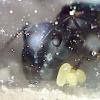Well, I'll start with one that I know nearly every southern California ant likes. Okay, dunno about "every"...but...almost every one I tried.
Lets skip suggestions of honey and sugar and insects. ![]() They are rather automatically included. Every single ant obviously likes those. The point of this is for lesser known foods that every ant likes.
They are rather automatically included. Every single ant obviously likes those. The point of this is for lesser known foods that every ant likes. ![]() And food that is hopefully cheap and easy to find (either in a store or online) that you'd think would be more widely used.
And food that is hopefully cheap and easy to find (either in a store or online) that you'd think would be more widely used.
Quinoa (get a huge thing of it on Amazon for cheap)
Cheap and easy to get (better to buy on Amazon or if you have an asian food market near you that might work just as good), and you can even grow it really easily and its a beautiful wheat-plant. Buy a bunch, crush some up and feed to your ants and then plant some and get more. Mine grew to 5 feet tall before the stupid idiotic gardeners (yay for having to live in apartments run by robots) cut it down and then I moved.
In any case, Quinoa looks like a weed when it first grows so you aren't actually supposed to pick any plant until it grows bigger (otherwise a lot of people pull out the actual Quinoa). It grows REALLY quick and grows REALLY tall (I think up to 12 feet from what I recall). But the plant itself is very beautiful and produces a lot of seeds. Typically grows in higher altitudes, but I had no issue AT all growing it in an irrigated apartment (well, except for gardeners). It was really healthy and after only 1 or 2 months, was getting flower buds on it.
I plan to grow some again, plant some seeds tomorrow. I'll be planting them by a river where it doesn't look like any gardeners go. Gardeners here don't tend to hack away and dig up plants I plant though, I have a bunch in front of my place and they are always left alone.
Anyway, list of ant species that like it after its crushed
I'll list the obvious
Any Pheidole, any Pogonomyrmex, any Messor and any other seed eating species. So, automatically all harvesters. Quinoa is a seed so no point in listing ants that eat seeds for primary food source. ![]()
Now the actual list (all tested on wild colonies and watched them come out to get it):
Argentine ants love it, Forelius (pruinosus/mccooki) love it, Dorymyrmex (bicolor and insanus) love it, Brachymyrmex love it, Formica (two different species tested on) love it, Camponotus (tested on Camponotus hyatti) love it, Solenopsis (tested on S. aurea, S. xyloni, S. invicta) love it. For a even better test, I tried it on...the species name I can never remember, but it looks like an alien ant that nests in acasia trees (the red bushes in arid-land California) and they loved it. I tried it on Camponotus modoc up in northern California a few years back and they love it.
Only ant that ignored it was...was Hypoponera I think? Very small ant. I think that is the one. That one only eats centipedes. I however DID see one worker gather a piece, but it was mostly ignored...seeing one worker gather it I should have done more tests. But, I ran out of time as I moved. They didn't show nearly as much interest as the other ants in any case.
As a further test, I tried it with Subterranean termites and...they actually gathered it up and ate it too. I did it on I think arid-land Subterranean termites (or might have been Desert subterranean termites. I also tried it on Formosan subterranean termites). Both species really liked it, which I thought was strange as they only eat wood. Could need further tests, as it might depend how much wood is in an area and how hungry they are (or were in this case).

















